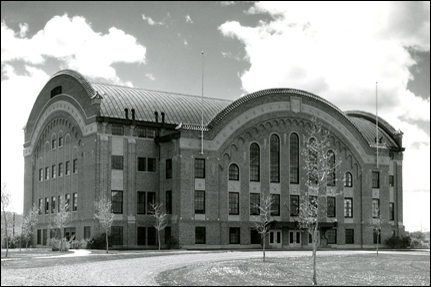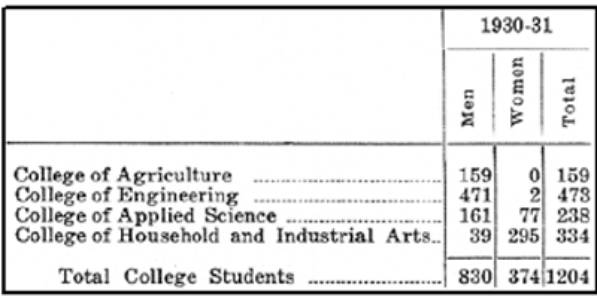Annals of MSC: 1919-1943
Note3
The flu raged worldwide during 1918 and 1919. Five thousand Montanans had died by the end of that year due to it. World War II also hit Montana hard because the military enlistments per capita for Montana were higher than for any other state. These tragedies were augmented again during the early years of this era by Montana experiencing a regional drought-caused depression when the rest of the country was booming.
At MSC, James Hamilton resigned as president in 1919 to become dean of men – a position he held for another two decades. Alfred Atkinson (4th MSC president, 1919–1937) took over the administration during the interim years between World War I and World War II. He was followed by A. L. Strand (5th MSC president, 1937–1942) who led MSC into the WWII years.
American universities moved beyond classical education into providing also job training, accreditation, and social status. MSC was well-suited to the task because agriculture and engineering were important fields in fulfilling the country’s extended aspirations. Atkinson placed special importance on training engineers. He appointed Earle B. Norris as Dean of the College of Engineering. Under his leadership, engineering became more science-based, promoted a professional ethos, and advocated for industrial development in the state.6 At the same time, Frederic B. Linfield, Dean of the College of Agriculture, assisted by the famous ag economist Milburn L. Wilson, built Agriculture “into a nationally respected source of expertise on applying industrial principles and scientific knowledge to agricultural expansion.”9 One would think that science-driven advancements in agriculture and engineering would have been enhanced by the application of statistical thinking, however, there was no growth in statistical instruction at MSC until after WWII.
During the 1920 election, the people of Montana overwhelmingly approved a small property tax to support the university system for 10 years and also approved a $5 million bond issue for new buildings. As a result, over the next few years, MSC completed Roberts Hall and built Ryon Labs for engineering. Lewis Hall and a new heating plant were constructed. Romney Gym was constructed in 1922, Herrick Hall was completed in 1926, and the Quads in 1935.12

Romney Hall - built 1922 (1932 photo)
In 1921, the college was officially renamed Montana State College, a name properly conveyed by the abbreviation MSC. Enrollment at that time was about
1200 students.
The 1920-21 Catalog, indicates that total college academic year expenses for a student were less than $500 ($6100 in 2017 dollars), including fees, books, room, board and incidental expenses; registration costs were negligible relative to the other expenses. The barracks built by the State and Federal government to accommodate the Students' Army Training Corps were used as living quarters and a dining room for men students. A significant number of men purchased room and board at their fraternity houses. Those who did not live in the men's dormitory could find room and board in private homes for $35 to $40 per month. Hamilton Hall provided housing for women; the typical cost for room and board was $36 per month.
The total college academic year expenses for a student remained the same in 1930 as in 1920, $500 ($7300 in 2017 dollars), although the real cost increased because of deflationary periods in the early and late 1920s. Non-resident students were required to pay an additional $75 fee per academic year.15
In 1940, the total expenses were $485 ($8500 in 2017 dollars). Thus, the real cost
of college steadily increased throughout this period. Non-residents continued to pay
an additional fee of $75 per academic year. Construction of the Quadrangle provided
housing for women students in addition to that available at Hamilton Hall. A student
cooperative housing organization was established during the spring quarter of 1937
to help men and women students lower their college expenditures by cooperative living.
All student members participated in the maintenance of the house and in buying and
preparation of food.18
Montana was hit hard by drought in1930 in addition to the continuing economic depression
affecting the entire country. Production dropped in Montana’s agriculture and mining
industries. However, unlike much of the state, the Gallatin Valley had plenty of water
during the Depression and its agricultural economy remained relatively strong. The
state’s situation changed when President Roosevelt’s New Deal Government began funding
Montana projects such as building the Fort Peck Dam. Between 1934 and 1941, the Federal
Government injected more than $430 million into the Montana economy. That investment rescued the mining industry and allowed many agricultural enterprises
to maintain their productivity.21

During the hard times of 1930-1931, MSC student enrollment was good, totaling 1204 registered collegiate students (see table at right). Since jobs were almost non-existent, young people came to college .24 The 1930 MSC faculty included 110 at professorial and instructor ranks, and a staff of 52 in the agricultural experiment station (counting some faculty twice because of joint appointments). The depression caused the state to reduce the college budget by 10% in 1931 and another 12% in 1933. Eleven staff members were dropped. Extreme drought conditions prevailed through 1936 and President Atkinson reported in 1935 that almost every staff member in agriculture had been offered higher salaries elsewhere. Appropriations remained low and more staff positions were unfilled until 1939 after the drought ended and the economy began to recover.27
President Atkinson resigned in 1937 to take the presidency at the University of Arizona and A. L Strand became the new president. The drought was ending and, with good crop years in Montana, monies were secured for new construction at MSC, including engineering laboratories and the Student Union building that opened in 1940.
By 1939, war had begun in Europe and the U.S. began defense preparations, efforts that included the college because the government contracted with MSC for the delivery of short courses on technical subjects (including mathematics) appropriate for the military, industry, and food production. The Army and Army Air Force sent trainees to MSC for 5-week courses. Fraternities were closed and women students lived in the fraternity houses. The military trainees were housed in the women’s dormitories and were provided food at the Student Union. An extensive nurses training program was also in operation during WWII. Enrollment in nurses training reached 343 by 1944 when the total MSC enrollment figure was only 1155.
Although MSC grew larger due to preparations for WWII, Montana as a whole saw its citizens emigrate to other states. They were attracted especially by abundant, well-paying jobs in the defense industries on the west coast. From 1940 to 1943, Montana’s population dropped by 15% and Gallatin County’s by 18%.30
During the war, 57,000 Montana men and women (approximately 10% of the population) served in the military; almost 1,900 servicemen were killed or missing-in-action. Through both World Wars, the response of Montana’s youth to U.S. defense was extraordinary.33
When the U.S. entered the war in December, 1941, students were advised to continue their studies until the government called them into service. The 1941 MSC enrollment reached 1800 students, the first time in the 20th century that the college had a larger enrollment than the university in Missoula. Football was abandoned 1942-45, but other campus activities continued as morale boosters.36
In 1942, President Strand resigned to become the president at Oregon State University. William Cobleigh presided over MSC as Acting President for almost a year. In the fall of 1943, the 50th anniversary of the founding of MSC, Ronald R. Renne (6th MSC president,1943-1964) began his long service as President of the Bozeman campus. Because of the war, the campus held only a modest observance of its anniversary.
Annals of MSC during Era 4
Next topic (National Events) in Era 3
Table of Contents
(Last revised: 2021-9-9)
